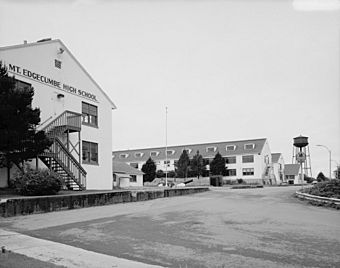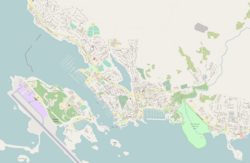Sitka Naval Operating Base and U.S. Army Coastal Defenses facts for kids
|
Sitka Naval Operating Base and US Army Coastal Defenses
|
|

Headquarters and barracks buildings at the base
|
|
| Location | Japonski Island, Makhnati Island and the causeway connecting them |
|---|---|
| Nearest city | Sitka, Alaska |
| Area | 510 acres (210 ha) |
| Built | 1939 |
| Built by | US Navy Seabees |
| NRHP reference No. | 86003559 |
Quick facts for kids Significant dates |
|
| Added to NRHP | August 11, 1986 |
| Designated NHLD | August 11, 1986 |
The Sitka Naval Operating Base and U.S. Army Coastal Defenses were important military sites near Sitka, Alaska. These places were built during World War II to protect Alaska. They included airfields and naval bases.
These bases were very important for defending Alaska. They also helped in military actions against Japanese forces. Japanese soldiers had taken over Attu and Kiska, two islands in the Aleutian Islands. The Sitka facilities were named a National Historic Landmark in 1986. This means they are very important historical places.
Contents
Why Sitka Was Important
In 1937, the United States Department of War started a small naval station near Sitka, Alaska. This was because a war in the Pacific Ocean seemed possible. The station was a base for PBY Catalina seaplanes. These planes could land and take off from water.
In 1939, the United States Congress gave money to build naval air stations. Sitka was one of these places. The Sitka station was built on Japonski Island. This island is just west of Sitka Harbor. The land had been controlled by the United States Navy since 1867. This was when the Alaska Purchase happened.
Building the Base
The Sitka Naval Air Station officially opened on October 1, 1939. At first, it was mainly a place to refuel ships with coal. But it quickly grew much bigger. A radio station, barracks (places for soldiers to live), and other buildings were built. Most of these were on the north side of Japonski Island.
In March 1941, United States Army soldiers arrived in Sitka. They started building a coastal defense battery on Makhnati Island. This is a small island west of Japonski Island. To help with this work, a long causeway was built. This causeway was about 8,100 feet (2,500 m) long. It connected Japonski Island to Makhnati Island.
When Japan attacked Pearl Harbor in December 1941, these were the only major American military sites in the North Pacific. They were still being built at the time.
The naval facilities on Japonski Island grew a lot. They included several hangars for planes. There were also ramps that went into the water. These helped seaplanes move from the water onto land. A large concrete parking area was built for planes. There was also a control tower and two piers (docks). Many other support buildings were also constructed.
The Navy also had a system on the island for landing and launching aircraft. It was similar to what aircraft carriers use. However, none of these specific facilities are still standing today.
Army Defenses and Fort Rousseau
Along the causeway to Makhnati Island, many buildings were built for the Army. These were for the coastal defense units. The main facility was called Fort Rousseau. It was on Makhnati Island. This fort had two large six-inch guns and two 155mm guns. It also had ammunition storage areas and the army's command post.
A second battery of guns was placed on Sasedni Island. This island also had barracks and a mess hall for soldiers. Virublennoi Island held three bunkers for ammunition. These gun batteries were not finished until after the Japanese had left Attu and Kiska. So, they never saw any real fighting. The army closed its base at Sitka in the spring of 1944. Today, only foundations and concrete structures remain.
The parts of the Sitka Naval Operating Base that still exist are very important. This includes the causeway to Makhnati Island and the coastal defense station. They were named a National Historic Landmark on August 11, 1986.



